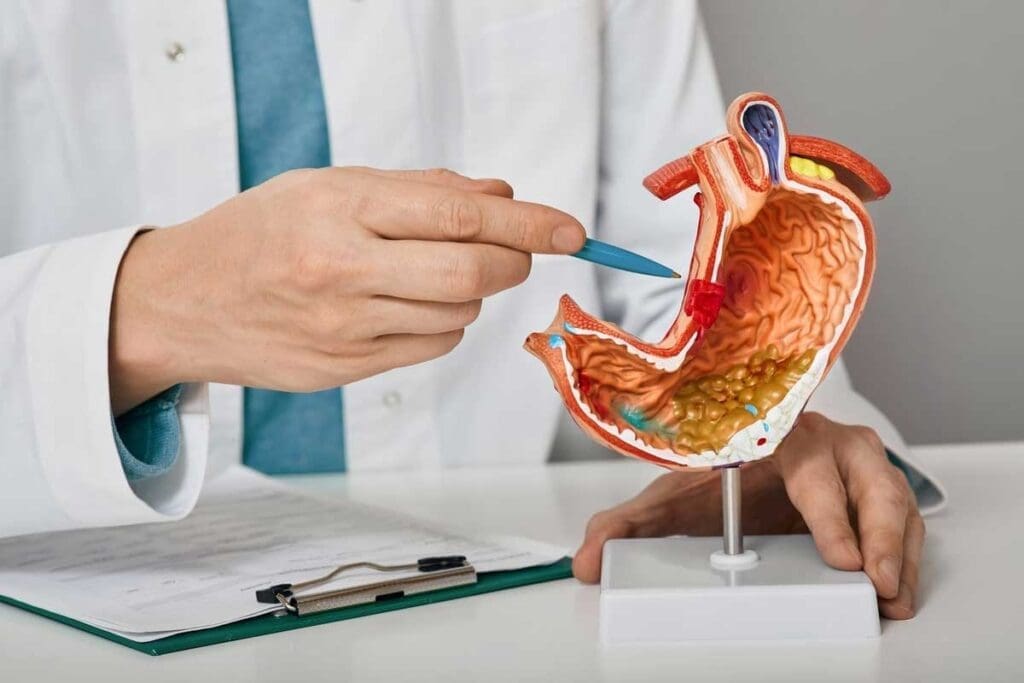Last Updated on November 17, 2025 by Ugurkan Demir
At Liv Hospital, we know how critical it is to stop blood clots. We offer effective treatments that are easy to manage, including blood clot injections in stomach, often with enoxaparin (Lovenox). These injections are given under the skin in the stomach area, are usually painless, and help prevent and treat deep venous thrombosis (DVT) and pulmonary embolism (PE). Enoxaparin is a low molecular weight heparin that works by thinning the blood to prevent clots from forming or growing larger. Treatment typically involves daily injections for a period, especially after surgery or during high-risk conditions. This approach is safe, effective, and supported by monitoring to minimize risks and ensure the best outcomes for patients prone to blood clots.

These injections act as blood thinners. They stop new clots from forming and prevent existing ones from getting bigger. Knowing how these injections work and their benefits helps patients manage their condition. Our approach ensures safe and reliable blood thinner treatments for those at high risk.
Anticoagulant injections are key in preventing blood clots in many cases. They help stop serious issues like deep vein thrombosis (DVT) or pulmonary embolism (PE). This is vital for those at risk of blood clots.
These injections stop the body’s natural clotting process. This is important for patients having major surgeries or those who are bedridden for a long time.
Blood-thinning stomach injections are given in the abdomen’s fatty tissue. Enoxaparin (Lovenox) is a common choice for this. They release the drug slowly into the blood, making it effective.
These injections help with many blood-clot-related issues. They treat:
In pregnancy, Lovenox is used to prevent clots in high-risk women. Though there are risks like bleeding, the benefits are often greater with proper care.
Enoxaparin, known as Lovenox, is a low molecular weight heparin (LMWH). It’s popular for preventing and treating blood clots. It’s effective and has a predictable effect, making it easier to use than traditional heparin.
| Condition | Treatment Duration | Monitoring Requirements |
| DVT Prevention | Until discharge or up to 35 days | Periodic CBC and anti-Xa levels |
| Pulmonary Embolism | At least 3 months | Regular assessment of renal function and CBC |
| Pregnancy Complications | Throughout pregnancy and postpartum | Monthly anti-Xa levels and CBC |
To understand how anticoagulant injections work, we need to know their mechanism. Anticoagulants, like low molecular weight heparins, are key in stopping blood clots. These clots can cause deep vein thrombosis (DVT) and pulmonary embolism.
The body naturally forms clots when a blood vessel is injured. This process involves many steps and clotting factors. It helps prevent too much bleeding.
But sometimes, the body forms harmful clots. Anticoagulants step in to stop these unwanted clots by interfering with the clotting process.
Low molecular weight heparins, like enoxaparin (Lovenox), activate antithrombin in the blood. Antithrombin then blocks key clotting factors, like thrombin and factor Xa. This prevents blood clots from forming.
The effect of enoxaparin peaks around 4 hours after injection and lasts for 12 hours. Its half-life is about 3-7 hours, depending on the dose and kidney function. This makes LMWHs a top choice for doctors.

LMWHs are very good at preventing DVT and pulmonary embolism. They are most effective in high-risk patients, like those having major surgery or who are bedridden.
| Condition | Treatment Duration | Effectiveness |
| DVT Prevention | Until discharge or 30 days | Highly Effective |
| Pulmonary Embolism Prevention | Until discharge or 30 days | Highly Effective |
| Post-Surgical Thromboprophylaxis | 7-14 days | Very Effective |
LMWHs, like enoxaparin, are key in preventing blood clots. They are safe, easy to use, and very effective. This makes them a top choice for doctors and patients alike.
Getting blood clot injections in the stomach might seem scary at first. But with the right help, you can learn to do it yourself. These shots are given just under the skin in your belly to stop blood clots.
Before you start giving yourself anticoagulant injections, you need to learn from a doctor. They will teach you how to do it right, stay safe, and handle any side effects. It’s a good idea to practice under their watch until you feel sure about it.
To give a shot in your stomach to stop blood clots, follow these steps:
The best place for low molecular weight heparins like enoxaparin is in the lower belly. It’s important to change where you inject to avoid soreness and bruises. The best spots are in the lower belly, at least 2 inches from your belly button.
Keeping your injection supplies in good shape is key. Store enoxaparin prefilled syringes at room temperature, away from sunlight and moisture. Always check the expiration date before using and throw away used syringes in a sharps container.
It’s important to know about the side effects of anticoagulant injections in the stomach. This is for your safety and to make sure treatment works well. When taking medicines like enoxaparin to stop blood clots, knowing the risks and benefits is key.
Enoxaparin injections can cause irritation or burning at the injection site. To avoid discomfort, change where you inject and follow the right techniques.
Pregnant women might take Lovenox to prevent blood clots. But it’s important to watch for side effects like bleeding, bruising, or skin reactions.
Injectable blood thinners can increase the risk of bleeding and bruising. Be careful and tell your doctor if you notice any unusual bleeding or bruising.
Knowing when to get medical help is critical. If you have severe side effects or signs of bleeding, call your doctor right away.
Knowing how long you need to take enoxaparin is key to preventing blood clots. It’s important to understand how long it stays in your body. Also, how long do you need it for different health issues and the tests you need?
Enoxaparin, found in Lovenox, is a type of anticoagulant. It starts working best about 4 hours after you get it and lasts for 12 hours. This helps decide how often you’ll get shots, usually once or twice a day.
A doctor said, “Enoxaparin’s predictable action makes it a top choice for doctors.”
“Thanks to its predictable action, doctors can manage blood clot risks well without needing to check often.”
The time you’ll take enoxaparin varies based on your health issue. For example, those having surgery might need it for a shorter time. But those with DVT or PE might need it longer.
| Condition | Typical Treatment Duration |
| Post-surgical DVT prevention | 7-14 days |
| DVT or PE treatment | 3-6 months |
| High-risk patients | Extended duration, sometimes lifelong |
Enoxaparin usually doesn’t need regular blood tests because it works so predictably. But, some people, like those with kidney problems or obesity, might need to be checked more often.
GoodRx helps make Lovenox more affordable. This is important for sticking to your treatment plan. “GoodRx often provides up-to-date pricing and savings options for Lovenox, making it more affordable for patients,” which is key for long-term treatment.
Switching from enoxaparin to other blood thinners needs careful planning. The exact timing depends on your health and the medicines involved.
In summary, knowing how long you’ll take enoxaparin is critical for preventing blood clots. By understanding its duration and how it’s monitored, doctors can create the best treatment plan for you.
Managing blood clots well means using the right medicine and getting affordable care. Stomach injections, like Lovenox, are often used to stop blood clots. It’s key to know your options, like GoodRx for cheaper blood thinners.
Healthcare teams, like Liv Hospital, show how important quality care is. They work together to improve patient results. By understanding the cost and care of blood clot prevention, patients can manage their condition better.
So, managing blood clots is more than just the right medicine. It’s also about having a supportive care system. Together, these help patients get better health results.
Blood-thinning stomach injections, like enoxaparin (Lovenox), prevent and treat blood clots. They act as anticoagulants. This helps stop new clots from forming and prevents existing ones from growing.
Low molecular weight heparins, such as enoxaparin, interfere with blood clotting. This prevents new clots and stops existing ones from getting bigger.
Side effects of Lovenox injections include bruising, redness, or pain at the injection site. There’s also a risk of bleeding and bruising. If you notice any unusual symptoms, seek medical help.
Enoxaparin is usually cleared from the body within a few days after the last dose. The exact time depends on kidney function and the dose given.
Yes, with proper training, patients can give themselves stomach injections. It’s important to follow a step-by-step technique and take precautions for safe and effective use.
The best sites for Lovenox injections are in the fatty tissue around the navel. Avoid a 2-inch radius around the belly button. Rotating sites helps prevent bruising and discomfort.
Yes, using Lovenox during pregnancy requires careful consideration. While it’s often safe, discuss your situation with your healthcare provider to ensure the best care.
GoodRx offers discounts and coupons to make Lovenox more affordable. Talk to your healthcare provider about financial options to find the best solution.
Monitoring needs for enoxaparin vary based on individual conditions and treatment plans. Generally, routine monitoring isn’t needed, but it depends on specific situations.
If you have bleeding or bruising on Lovenox, seek medical help right away. Your healthcare provider can guide you on managing these risks.
Subscribe to our e-newsletter to stay informed about the latest innovations in the world of health and exclusive offers!